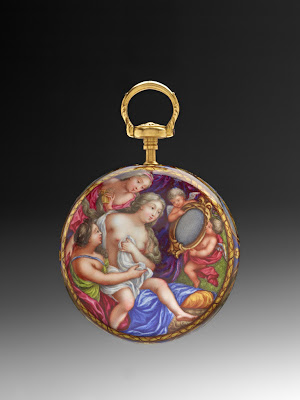 |
| The Portico Gallery of the Frick Collection museum where the timepiece exhibit is being held. |
An exhibition that just opened at the Frick Collection museum explores the discoveries and innovations made in the field of horology from the early 16th to the 19th century. It features 16 clocks and 14 watches that chronicle the evolution over the centuries of more accurate and complex timekeepers and illustrate the aesthetic developments that reflected Europe’s latest styles.
Titled, “Precision and Splendor: Clocks and Watches,” the exhibition is being shown in the new light-filled Portico Gallery of the stately mansion that was once the home of American industrialist Henry Clay Frick. The exhibition will run till February 2014.
Luxury watch brand, Breguet, is a major sponsor. The exhibition concludes with three of its early timepieces—including a watch that displayed “decimal time,” a short-lived movement in 18th Century France that divided the day into ten hours and the year into ten months.
 |
| Breguet gilt-bronze Carriage Clock by Abraham-Louis Breguet and Antoine-Louis Breguet with Calendar (1811). |
The exhibition, which I attended Wednesday, examines both the mechanical innovations that increased the accuracy of the timepieces along with the elaborate ornamentation. At first, these pieces were prized for their innovation and their beauty and owned by only the wealthiest individuals as show pieces. Slowly through technical advancements that made them more portable, less expensive, more reliable and more of a necessity, they became widely available.
 |
| Gilt-Brass and Silver Table Clock with Astronomical and Calendrical Dials (Circa 1653). Photo credit: Michael Bodycomb |
The existence of mechanical clocks was made possible by an invention known as an escapement. Falling weights (and later springs) provided the energy to power the clock’s mechanism, while the escapement regulated the rate at which that energy was delivered to the oscillator (at first a simple balance and later a pendulum). The introduction of the escapement gradually caused the shift away from time-finding devices (sundials) and time-measuring devices (water clocks) to timekeepers (clocks and later watches) as advances in science and technology were made.
In addition to the Breuget timepieces, other notable pieces in the collection include an Augsburg Maker, gilt-brass tower table clock (circa 1580), which displays time only by the hour; a spring-driven pendulum clock on a bracket in a elaborate case made of gilt bronze, enameled metal, and glass (circa 1735); and a gold and enamel pendant watch (circa 1685) that depicts the painting The Toilet of Venus by Simon Vouet.
The Frick Collection galleries is located at 1 East 70th St.
Please join me on the Jewelry News Network Facebook Page, on Twitter @JewelryNewsNet and on the Forbes Website.








